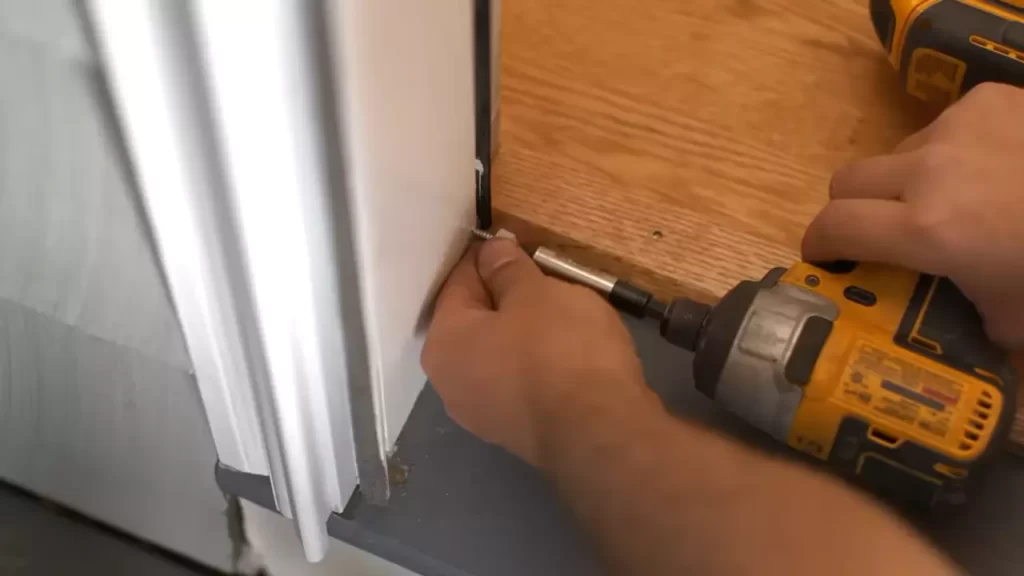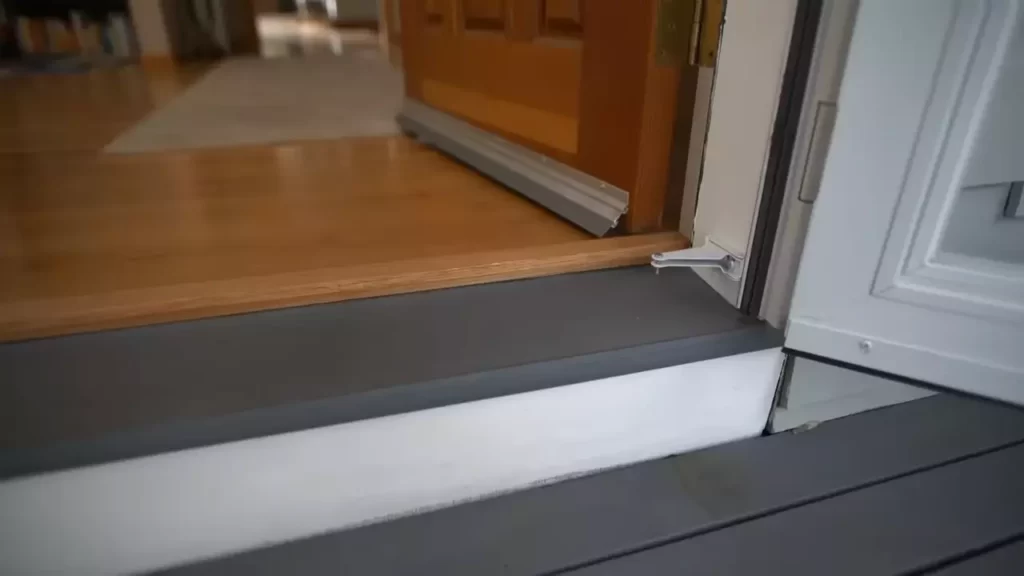To install a wood threshold, measure the width of the doorway and cut the threshold to fit. Then, use adhesive or screws to secure the threshold in place.
Wood thresholds are an essential component for maintaining the aesthetics and functionality of doorways. Whether you are replacing an old one or installing a new threshold, proper installation is crucial to ensuring a seamless transition between different flooring surfaces. By following a few simple steps, you can easily install a wood threshold and enhance the overall appeal of your home or office space.
This article will guide you through the process, providing clear instructions for measuring, cutting, and securing the threshold in place. Get ready to upgrade your doorway with a new wood threshold that will not only improve the visual appeal but also provide durability and longevity.
Preparing For Installation
Installing a wood threshold is a great way to add a finishing touch to your doorway and provide a smooth transition between different flooring surfaces. Before you dive into the installation process, it’s important to take the necessary steps to prepare for a successful and seamless installation.
This includes gathering the necessary tools and materials, measuring and marking the desired placement of the wood threshold, and preparing the floor surface. Let’s walk through each of these steps to ensure a smooth and hassle-free installation.

Gather the necessary tools and materials
Before you start installing the wood threshold, make sure you have all the tools and materials you’ll need. Here’s a handy list to help you get organized:
| Tools | Materials |
|---|---|
|
|
Measure and mark the desired placement of the wood threshold
Accurate measurements are crucial for a precise installation. Use a measuring tape to determine the width and depth of the doorway where the threshold will be placed. Mark these measurements on the floor with a pencil or masking tape. Additionally, take into consideration any slopes or unevenness in the subfloor that may require adjustments to ensure a level installation. Double-check your measurements before proceeding to the next step.
Prepare the floor surface for installation
Before installing the wood threshold, it’s important to prepare the floor surface to ensure a secure and stable installation. Follow these steps:
- Remove any existing thresholds or trim that may be in place.
- Clean the floor surface thoroughly, removing dust, dirt, and debris.
- If necessary, sand down any rough or uneven areas of the subfloor.
- If you’re installing the wood threshold over the carpet, consider using a flooring adhesive to secure the threshold in place.
By preparing the floor surface properly, you’ll create the ideal foundation for installing a wood threshold that will not only look great but also withstand daily foot traffic for years to come.
With the necessary tools gathered, the correct measurements in place, and the floor surface properly prepared, you’re now ready to move on to the installation process. Stay tuned for our next blog post to learn how to install a wood threshold seamlessly.
Removing The Old Threshold
When it comes to installing a new wood threshold, the first step is to remove the old one. This process requires some careful preparation and the right tools to ensure a smooth and successful removal. In this section, we will go through the necessary steps to safely remove the old threshold and prepare the area for the installation of the new one.
Assess the condition of the existing threshold
Before removing the old threshold, it is important to assess its condition. Check for any signs of damage, such as warping, rot, or termite infestation. If the threshold is severely damaged, it may need to be replaced entirely. However, if the damage is minimal, you may be able to repair it instead. Assessing the condition of the threshold will help you determine the best course of action for removal.

Safely remove the old threshold
Once you have assessed the condition of the existing threshold, you can proceed with its removal. Follow these steps to safely remove the old threshold:
- Start by removing any screws or nails that are securing the threshold to the floor. Use a screwdriver or a pry bar to carefully loosen and remove them.
- Next, insert a thin pry bar or a putty knife under the edge of the threshold. Gently pry it up from the floor, starting at one end and working your way towards the other. Be careful not to damage the surrounding area during this process.
- If the threshold is glued down, you may need to use a heat gun to soften the adhesive. Apply heat to the edges of the threshold and use the pry bar or putty knife to lift it up.
- Continue prying up the threshold until it is completely free from the floor. Take your time and work slowly to avoid any unnecessary damage.
- Once the threshold is removed, check the subfloor for any remaining nails or adhesive residue. Remove them using pliers or a scraper.
Clean and prepare the area for the new installation
After the old threshold has been safely removed, it is important to clean and prepare the area for the new installation. Follow these steps to ensure a smooth and secure installation:
- Clean the subfloor thoroughly to remove any dirt, dust, or debris. This will help create a clean and level surface for the new threshold.
- If needed, use a leveling compound to fill in any uneven areas on the subfloor. This will help ensure that the new threshold sits flat and securely.
- Measure the width and length of the opening to determine the size of the new threshold. Trim the new threshold accordingly, if necessary, using a saw or a chisel.
- Apply a thin layer of adhesive to the back of the new threshold. Make sure to use an adhesive that is appropriate for wood and the flooring material.
- Carefully position the new threshold in place, ensuring that it fits snugly against the door frame. Press it firmly onto the subfloor to secure it in place.
- Allow the adhesive to dry completely before walking or placing any weight on the threshold. This will ensure a strong and durable installation.
By following these steps, you can successfully remove the old wood threshold and prepare the area for the installation of a new one. Remember to assess the condition of the existing threshold, safely remove it, and clean and prepare the area before proceeding with the new installation. With proper care and attention, your new wood threshold will provide a beautiful and functional transition between rooms.
Choosing The Right Wood Threshold
When it comes to installing a wood threshold, choosing the right one is essential. Not only does it serve as a transition between different flooring surfaces, but it also adds an aesthetic appeal to your space. To make an informed decision, there are several factors to consider. This article will guide you through understanding the different types of wood thresholds available, considering factors such as durability, style, and budget, and selecting the appropriate wood species for your specific needs.
Understand different types of wood thresholds available
Before you jump into purchasing a wood threshold, it’s important to understand the various types available. Each type offers unique features and benefits that may suit your requirements differently. Here are the main types:
| Type | Description |
|---|---|
| Flush Threshold | This type of threshold is installed level with the floor surface, providing a seamless transition between rooms. |
| T-Molding Threshold | T-Molding thresholds are used to bridge the gap between two floors of equal height. They create a clean and polished look. |
| Overlap Threshold | Overlap thresholds overlap the adjoining floor, providing a gradual transition between two flooring surfaces at different heights. |
Consider factors such as durability, style, and budget
When choosing a wood threshold, it’s essential to consider factors such as durability, style, and budget to ensure it meets your specific requirements. Here are some important considerations:
- Durability: Look for a wood species that is known for its durability and resistance to wear and tear. Hardwood species such as oak, maple, or mahogany are excellent options.
- Style: Consider the overall aesthetic of your space. Choose a wood threshold that complements your flooring and enhances the design style you desire.
- Budget: Set a budget for your wood threshold installation project. There are various price ranges available, depending on the wood species and quality.

Select the appropriate wood species for your specific needs
Each wood species offers distinct characteristics that may make it more suitable for specific needs. Here’s a list of common wood species used for thresholds and their qualities:
- Oak: Oak is a popular choice due to its strength and durability. It is resistant to rot and insect damage, making it ideal for high-traffic areas.
- Maple: Maple is known for its hardness, making it highly resistant to dents and scratches. It provides a clean and contemporary look.
- Mahogany: Mahogany is a luxurious wood species that adds elegance and warmth to any space. It is resistant to moisture, making it suitable for bathrooms and kitchens.
- Walnut: Walnut is a dark-colored wood species that offers a rich and luxurious appearance. It is known for its stability and resistance to warping.
By considering the different types of wood thresholds available, evaluating factors like durability, style, and budget, and selecting the appropriate wood species for your specific needs, you’ll be well-equipped to install a wood threshold that not only serves its practical purpose but also enhances the overall look and feel of your space.
Measuring And Cutting The Wood Threshold
Accurately measure the dimensions of the doorway
Before installing a wood threshold, it is crucial to accurately measure the dimensions of the doorway. This will ensure a proper fit and avoid any installation issues. To measure the doorway, follow these steps:
- Start by measuring the width of the doorway. Use a tape measure to measure the distance between the inner edges of the door frame. Make sure to measure at the widest point of the doorway as the width may vary.
- Next, measure the height of the doorway. Use a tape measure to measure the distance from the bottom of the door frame to the floor. This measurement will determine the height of the wood threshold.
Once you have accurately measured the dimensions of the doorway, you can proceed to determine the appropriate length and width for the wood threshold.
Determine the appropriate length and width for the wood threshold
After measuring the dimensions of the doorway, it is important to determine the appropriate length and width for the wood threshold. To do this, follow these steps:
- For the length, measure the width of the doorway and add a few inches on each side for an overhang. This will ensure that the wood threshold covers the entire width of the doorway and provides a seamless transition.
- For the width, measure the height of the doorway and add a few inches for a proper overlap. The width of the wood threshold should be wide enough to cover the gap between the door frame and the floor.
Once you have determined the appropriate length and width for the wood threshold, it is time to cut the piece to size.
Use proper tools and techniques to cut the wood threshold to size
To cut the wood threshold to the appropriate size, you will need the following tools:
- Measuring tape
- Pencil
- Saw (circular saw or hand saw)
- Clamps (optional, but recommended for stability)
Once you have gathered the necessary tools, follow these steps to cut the wood threshold:
- Measure and mark the determined length and width on the wood threshold using a measuring tape and pencil.
- Secure the wood threshold tightly using clamps to ensure stability during the cutting process.
- Using a saw, carefully cut along the marked lines. Make sure to follow a smooth and straight cutting motion to achieve clean and precise edges.
- Once the wood threshold is cut to size, remove any excess debris and sand the edges if necessary.
By using proper tools and techniques to cut the wood threshold, you will ensure a precise fit and a smooth installation.

Sanding And Finishing The Wood Threshold
Once you have installed your wood threshold, it’s important to sand and finish it to ensure a smooth and durable surface. This process not only enhances the appearance of the threshold but also helps protect it from wear and tear. In this section, we will discuss the steps involved in sanding and finishing the wood threshold to give it a clean and polished look.
Smooth any rough edges or surfaces
Before applying any finish or sealant, it’s crucial to smooth out any rough edges or surfaces on the wood threshold. This can be done using sandpaper with medium to coarse grit. Gently sand the wood in the direction of the grain, taking care to not sand or apply too much pressure. Regularly check the surface to ensure all rough areas are smoothed out. Once you are satisfied, move on to the next step.
Apply a suitable finish or sealant to protect the wood
Applying a suitable finish or sealant to the wood threshold is essential to protect it from moisture, stains, and general wear and tear. There are a variety of finishes available, including varnish, polyurethane, or wax, depending on your preference and the level of protection required. Use a brush or a soft cloth to apply the finish evenly over the entire surface of the threshold. Be sure to follow the manufacturer’s instructions for application and drying time.
Allow sufficient drying time before installation
Once the finish or sealant has been applied, it’s important to allow sufficient drying time before installing the wood threshold. This ensures that the finish has properly cured and will provide maximum protection. Check the manufacturer’s instructions for the recommended drying time, as it can vary based on the type of finish used. Avoid walking or placing any objects on the threshold during this drying period to prevent any damage to the finish.
In conclusion, sanding and finishing the wood threshold is a vital step in the installation process. By smoothing out rough edges, applying a suitable finish, and allowing ample drying time, you can ensure that your wood threshold not only looks great but also remains protected for years to come.
Installing The Wood Threshold
Installing a wood threshold is a straightforward and important step when it comes to finishing off your flooring project. Not only does it add a professional touch, but it also helps to bridge the gap between two different types of flooring. In this guide, we will walk you through the process of installing a wood threshold, ensuring proper alignment and stability for a seamless finish.
Position the wood threshold in place
Before securing the wood threshold, it’s crucial to position it correctly. Start by measuring the width of the doorway and cut the threshold to size if necessary. Place the threshold in the desired location, making sure it aligns perfectly with the edges of the flooring. You can use a tape measure and level to help you achieve accurate positioning.
Secure the threshold with screws or nails
Once you have positioned the wood threshold, it’s time to secure it in place. Use screws or nails, depending on the material of the threshold and the subfloor. Make sure to choose screws or nails that are appropriate for your specific flooring type. Pre-drill holes slightly smaller than the screws or nails to prevent the wood from splitting. Then, carefully attach the threshold to the subfloor, ensuring it sits flush with the flooring on both sides.
Ensure proper alignment and stability
Proper alignment and stability are essential to guarantee a durable and visually pleasing wood threshold installation. After securing the threshold, double-check its alignment with the surrounding flooring. Make any necessary adjustments to ensure a seamless transition. Pay attention to stability as well, ensuring there is no wobbling or movement when pressure is applied. This will prevent any potential tripping hazards and ensure the longevity of the installation.
By following these steps and adhering to proper installation techniques, you can successfully install a wood threshold that not only enhances the aesthetic appeal of your flooring but also provides a smooth and secure transition point. Take your time, measure carefully, and make sure to use the appropriate fasteners and tools. With a little bit of patience and attention to detail, you’ll have a beautiful wood threshold in no time.

Ensuring A Proper Seal
Apply a weather-resistant sealant or adhesive beneath the threshold
One of the most important steps in ensuring a proper seal for your wood threshold is to apply a weather-resistant sealant or adhesive beneath it. This will protect the wood from moisture and prevent any water or drafts from seeping through. Make sure to choose a high-quality sealant that is suitable for wood surfaces and outdoor use. Apply a generous amount of sealant or adhesive along the entire length of the threshold, making sure to cover any cracks or gaps.
Check for any gaps or unevenness
Before installing the wood threshold, thoroughly inspect the area where it will be placed to check for any gaps or unevenness. Use a level to ensure that the floor is perfectly level and make any necessary adjustments if needed. If you notice any gaps between the threshold and the floor, fill them with wood shims or a suitable filler to create a smooth and even surface. This will help create a tight seal and prevent any drafts from entering your home.
Test the seal by pouring water near the threshold and checking for leaks
Testing the seal of your wood threshold is crucial to ensure that it is properly installed and will protect your home from water damage. To test the seal, pour a small amount of water near the threshold and observe if there are any leaks. Pay close attention to the corners and edges, as these are common areas where water may seep through. If you notice any leaks, apply additional sealant or adhesive to the affected areas and retest. Once you have confirmed that there are no leaks, you can be confident that your wood threshold is properly sealed and will provide an effective barrier against moisture and drafts.
Follow these steps to ensure a proper seal for your wood threshold installation. By applying a weather-resistant sealant or adhesive, checking for any gaps or unevenness, and thoroughly testing the seal, you can protect your home from moisture and drafts. A well-sealed wood threshold not only adds a finishing touch to your doorway but also helps maintain a comfortable and energy-efficient living environment.
Final Touches And Maintenance Tips
Clean the wood threshold and surrounding area
To ensure a smooth and seamless finish, it’s essential to clean both the wood threshold and the surrounding area before finalizing the installation. Start by removing any dirt, debris, or adhesive residue using a damp cloth or sponge. If there are stubborn stains or grime, you can use a mild cleaning solution mixed with water to gently scrub the surface. Remember to dry the area completely before proceeding.
Make any necessary adjustments or repairs
Before completing the installation, it’s crucial to check for any adjustments or repairs that may be required. Inspect the wood threshold for any cracks, splits, or damaged sections. If there are any issues, use sandpaper to smooth out rough areas or fill cracks with a wood filler. Allow the filler to dry completely before sanding it down to create a level surface. This step ensures the threshold is in optimal condition and enhances its durability.
Regularly maintain and care for the wood threshold to prolong its lifespan
Proper maintenance is key to extending the lifespan of your wood threshold. Here are some essential care tips:
- Regularly sweep or vacuum the area to prevent dirt and debris buildup on the threshold.
- Wipe spills or moisture immediately to prevent absorption by the wood, which can lead to warping or staining.
- Avoid using harsh cleaning chemicals or abrasive tools that can damage the wood surface.
- Apply a protective sealant or finish to enhance the wood’s resistance to moisture, UV rays, and wear and tear. Follow the manufacturer’s instructions for best results.
- Inspect the threshold periodically for any signs of damage or wear. Address any issues promptly to prevent further deterioration.
By following these maintenance tips, you can ensure that your wood threshold remains in top condition, enhancing the aesthetics and functionality of your space for years to come.
Frequently Asked Questions For How To Install Wood Threshold
How Do You Fasten A Wooden Threshold?
To fasten a wooden threshold, follow these steps:
1. Measure the threshold and mark the placement on the floor.
2. Pre-drill holes in the threshold to prevent splitting.
3. Apply adhesive or construction adhesive along the bottom side.
4. Align the threshold with the marks and screw it into place.
5. Use a hammer to tap the finishing nails for extra security.
How Do You Nail A Wooden Threshold?
To nail a wooden threshold, follow these steps:
1. Measure and mark the desired position of the threshold.
2. Use a drill to create pilot holes along the marked line.
3. Position the threshold and secure it with nails, ensuring it sits flush with the floor.
4. Hammer the nails into the pilot holes, driving them through the threshold and into the subfloor.
5. Check for stability and make any necessary adjustments.
How Do You Stick Down A Door Threshold?
To stick down a door threshold, follow these steps: Clean the surface. Apply an adhesive layer on the bottom of the threshold. Position it in place. Press firmly down. Use weights or clamps to keep it in position while drying.
How Do You Fasten A Threshold?
To fasten a threshold, follow these steps:
1. Position the threshold in place, aligning it with the door frame.
2. Drill pilot holes through the screw holes in the threshold and into the subfloor.
3. Insert screws into the pilot holes and tighten them securely.
4. Check for any gaps or unevenness and make adjustments if needed.
5. Test the threshold for stability and ensure it is properly secured.
Conclusion
Installing a wood threshold is a simple and effective way to enhance the appearance and functionality of your door. By following these steps, you can ensure a smooth and secure installation process. Remember to measure accurately, use the right tools and materials, and take your time to achieve the best results.
With a beautifully installed wood threshold, you can create a seamless transition between rooms and provide added protection against drafts and moisture. Happy threshold installation!
